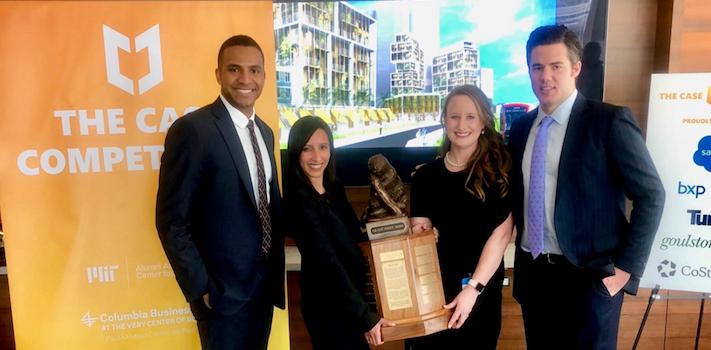
The Georgetown Team poses with their first-place trophy. From left: Andrew Hall, Neha Kapoor, Maura McGraw, and Jack Galvin.
For the third time in five years, a team from Georgetown University’s Real Estate graduate program has won the top prize in The CASE Competition, making Georgetown "the winningest graduate program in the history of the CASE Competition," according to the press release.
The annual contest—started in 2009 by the Alumni Association for the MIT Center for Real Estate (AACRE)—challenges teams to analyze and submit proposals for a complex, mixed-use development site.
Twenty-one teams entered the competition, and 12 were selected to attend the April 12–13 semifinals in San Francisco. In addition to Georgetown, the other two teams that advanced to the finals were MIT and Columbia University.
Georgetown also won first place in 2014 and 2016, the last year MIT sponsored the contest on its own. In 2017, it began running the contest as part of a consortium that also includes Harvard Business School, The University of Cambridge, Columbia Business School, and Hong Kong University of Science and Technology.
Before this year’s finalists were announced, the 12 semifinalist teams gathered in an auditorium in the new 1,070-foot Salesforce Tower in downtown San Francisco, where they waited to hear which three teams would be chosen to go onstage and make their presentations
“It’s kind of a pressure cooker,” said Georgetown team member Maura McGraw, a student in the Real Estate program who is also the founder of Duratus Properties in Birmingham, Alabama, and an officer in the United States Marine Corps Reserve. “You just go up there not knowing what’s going to happen.”
The other students on the winning team were Andrew Hall, a project and construction manager for PROCON; Neha Kapoor, an associate for The Carlyle Group; and Jack Galvin, vice president for the JCR Companies.

The Georgetown Team in the new Salesforce Tower in San Francisco. From left: Jack Galvin, Neha Kapoor, Maura McGraw, and Andrew Hall.
Creating a “More Vibrant” Environment
This year’s contest—titled “Brother, Can You Spare a Dime?”—challenged the students to confront two of San Francisco’s biggest problems: a critical shortage of affordable housing and a burgeoning homeless population. To address those issues, it offered the teams a prime piece of city-owned real estate for constructing a mixed-use, public-private facility that could bring people together and revitalize a neglected part of downtown.
Embarcadero Plaza is a three-and-a-half-acre park adjacent to the city’s bustling financial district. Despite its historic location near the waterfront and proximity to a planned transportation hub, the park has become dilapidated and serves as a makeshift campsite for the homeless. The competition challenged the teams to replace the existing plaza with a project that would “create a more vibrant and interactive urban environment” and do it in a way that would maximize the city’s financial return on the property. The city would then use this revenue to address homelessness and other critical issues.
The Georgetown team’s proposal envisions more than 600 housing units located in three airy, light-filled towers, surrounded by retail, parkland, and other community spaces. More than 200 affordable units would be intermixed throughout the project.
The teams had the option of addressing the homeless issue in one of two ways: by donating a portion of the revenue from the project to homeless centers off-site, or by including the homeless residences and services in the project itself. Georgetown’s team chose the second approach.
“We just decided we were going to address the problem head-on,” McGraw said.
The proposal includes 68 transitional, supportive units for homeless people, who would be supported by service on the site. Citing New Orleans’ Café Reconcile as a prototype, the plan envisions a farm-to-table restaurant, run by a celebrity chef who would train and employ some of the supportive housing residents.
Breaking with the Past
The plaza was formerly named for Justin Herman, the head of the San Francisco Housing Authority in the 1960s and early ’70s; however, last year the city’s Recreation and Parks Commission dropped that name at the urging of the Board of Supervisors. Herman is credited with the development of San Francisco’s Western Addition, but the action also displaced thousands of poor and minority residents. In 1970, he said that “this land is too valuable to permit poor people to park on it.”
This year’s CASE competition represents an attempt to take the city in a different direction. With deep-rooted problems at both ends of the housing spectrum—rapidly escalating prices at one end, and persistent homeless among individuals and families at the other—the contest recognizes that San Francisco cannot truly thrive until all residents share in its prosperity.
“Our goal was not to displace more people,” said team member Andrew Hall. “It was to bring community back to the plaza.”